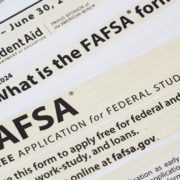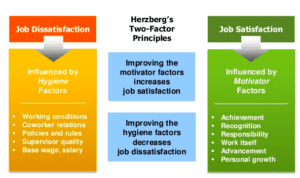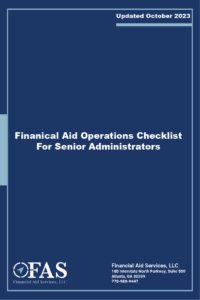Preparing for the 2024-25 Award Year: Understanding the FAFSA Simplification Act
By: Tiffany Motyka, Ed.D., FAS Senior Consultant
The term simplification is defined as ‘to make simpler’ or ‘to make more intelligible’. However, the FAFSA Simplification Act can appear to any college or university like the new requirements are the opposite. The changes began in the 2021-22 Award Year when limitations on student eligibility related to Selective Service registration, drug convictions, and subsidized usage limitations were eliminated. These changes were very welcome to the Financial Aid community. However, things began to get more serious in the 2023-24 Award Year when changes to the statutory definition of cost of attendance (COA), professional judgment requirements, determinations of independence, and the application process for unaccompanied homeless youth and foster care youth were published. These updates required institutions to change long-held language and terminology and specified the dynamics of the cost of attendance figures and the Professional Judgement processes.
Amid the 2023-24 Award Year changes, there was also a looming responsibility schools were trying to grapple with for the coming 2024-25 Award Year. Students would be asked to complete a reformatted FAFSA, become “contributors”, and provide consent for a more streamlined transference of newly designated Controlled Unclassified Federal Tax Information (FTI). The 2024-25 FAFSA would not be available until New Year’s Eve, a change from the October 1st date many families and schools were used to. This delay, however, would not soften the severity of what was then to become the biggest changes of the FAFSA Simplification Act, the Student Aid Index (SAI). This concept would require changes to financial aid vernacular and long-lived terminology shared among students, parents, financial aid administrators, and student information systems. The SAI calculation would eliminate the need for certain FAFSA information and instead of zero being the best option, a negative SAI could result. New markers such as AGI, poverty thresholds, family size, state of residence, and federal means-tested benefits would now allow families to be automatically eligible for maximum Pell Grant or minimum Pell Grant, but the Simplified Needs Test (SNT) and Auto-Zero calculations from previous years would be eliminated.
As the financial aid community began to digest the FAFSA Simplification requirements, they also began to wonder how the technology will be ready for the 2024-25 Award Year. First, schools would need to sign up for a new Student Aid Internet Gateway (SAIG) mailbox just to import the new FAFSA submissions due to the CUI designation of the Federal Tax Information. Programs like TDClient and EdConnect would have to be updated to cooperate with the new mailbox. However, the largest burden seemed to fall at the feet of the student information system companies. They must ensure the new SAI calculations are formulated correctly, the new FAFSA fields are included, and old ones removed, the vernacular is changed, a mechanism is included to report campus-based earnings to COD, and most importantly the software releases are provided to schools in a timely manner. The SIS companies must ensure schools have a way to determine cost of attendance when the FAFSA no longer offers housing choice. The proration of Pell Grant awards must now be based on enrollment intensity and not a prorated disbursement as in prior years. Year-round Pell Grant cannot be limited to only half-time enrolled students. Negative SAI figures must be used for determination of Pell Grant but cannot be used to determine need. Systems must ensure that there is only one Student Aid Index, no matter the number of terms enrolled. The outcry of concern from current users was visceral and began to sharpen the focus of the SIS companies. The financial aid community provided insight and regulatory interpretation and demonstrated the important relationship between financial aid administrators and the necessary technology to support aid recipients.
Once the Student Information Systems are delivered and contain all required updates, institutions still must make updates needed to comply with the FAFSA Simplification Act. These changes include ensuring the newly revamped FAFSA/ISIR comment codes are updated and correlate to any documentation or action required from the student, parent, or school. Cost of Attendance designations often include housing choice but since that question has been removed from the FAFSA, schools will need to determine how to identify and include that designation in the COA without postponing student awarding and disbursement. Any FAFSA fields that were removed and updated which resulted in new SIS fields will need to be updated in any existing rules, algorithms, and schedulers. Other stakeholders will need to be updated on the changes and ensure all marketing materials are updated to remove old information such as EFC. Federal work-study earnings must be provided to and accepted by the Department of Education to ensure that information is included in the FAFSA data. The administrative burden is intense but necessary to ensure the goals of the FAFSA Simplification Act come to fruition. Colleges and universities are preparing for these changes by communicating with each other, assisting student information systems with feedback on releases to come, and educating families on the new FAFSA and awarding processes. The additional effort amongst the financial aid community and its stakeholders can make a tremendous difference in the lives of the students and families we serve.
Are you facing staffing challenges at your institution that will affect your ability to handle the upcoming federal changes?
Contact FAS today for a quick consultation on how we can help you discover solutions tailored to your unique needs. Reach out at 770.988.9447 or via email at info@FinancialAidServices.org. We look forward to connecting with institutions ready to overcome challenges and elevate their financial aid and student business services.
About FAS
Financial Aid Services (FAS) has served higher education for over 30 years. Located in Atlanta, Georgia, FAS provides consulting, staffing, processing, and assessment services to assist institutions with improving operational efficiency, student satisfaction, and regulatory compliance in financial aid and student business services. FAS’ accomplished team averages 28 years of experience and has a combined 1,600 years of higher education experience. With clients in 49 states, FAS has successfully served over 1,800 institutions nationwide. The Company’s extensive experience combined with industry-leading expertise and focus on superior client outcomes, enables FAS to deliver lasting results to its clients and the students they serve. Visit www.FinancialAidServices.org for more information.







 Dawn Patak is a financial aid professional with over 25 years of experience. My financial aid career began as a financial aid counselor at Alfred University. Over the years, I ascended the ranks, moving into assistant and associate director positions at Keuka College, the University of Rochester, and Hobart and William Smith Colleges. I also held a relationship management role with the New York Higher Education Services Corporation (HESC). I worked as an independent contractor consultant with Financial Aid Services in 2016-17 and 2021-22 in between permanent positions as Director of Financial Aid at Finger Lakes Community College, Baltimore City Community College, and Hobart and William Smith Colleges. I recently came back to FAS as a Senior Consultant in August 2023.
Dawn Patak is a financial aid professional with over 25 years of experience. My financial aid career began as a financial aid counselor at Alfred University. Over the years, I ascended the ranks, moving into assistant and associate director positions at Keuka College, the University of Rochester, and Hobart and William Smith Colleges. I also held a relationship management role with the New York Higher Education Services Corporation (HESC). I worked as an independent contractor consultant with Financial Aid Services in 2016-17 and 2021-22 in between permanent positions as Director of Financial Aid at Finger Lakes Community College, Baltimore City Community College, and Hobart and William Smith Colleges. I recently came back to FAS as a Senior Consultant in August 2023.
 Can you discuss any limitations of your study and how they may impact the validity of your findings? (I’m thinking regionality)
Can you discuss any limitations of your study and how they may impact the validity of your findings? (I’m thinking regionality)